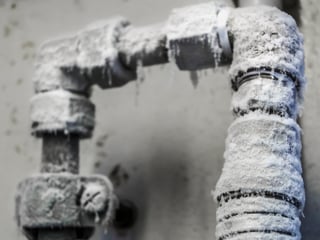 Property managers and owners should be ever mindful of and take steps to manage the risks of damage due to a water pipe which has burst due to freezing. More than 20 years ago, The Insurance Institute for Property Loss Reduction (IIPLR) estimated the cost of insured residential construction freeze-related losses exceeded $4 billion over the previous decade. A study conducted in the mid 1990’s (Gordon) noted that the risk of freeze damage was particularly high in the southern states where more mild winter temperatures prompt builders to employ building practices that are insufficient to protect water pipes from exposure to occasional sub-freezing temperatures. Furthermore, unsuspecting property owners may tend to pay less attention to potential damages that can result from water pipes that are only occasionally exposed to freezing temperatures. The IIPLR research work recommended establishing an outdoor temperature alert threshold of 20° F for the southern states. While property owners should be on high alert when outdoor temperatures drop into the low 20’s, the risk of freeze related pipe bursting still exists whenever outdoor temperatures remain significantly below freezing for extended time periods. This is especially true where there are uninsulated pipes directly exposed to outdoor temperatures or there are holes in the exterior shell of a building that allow the outdoor air to impinge directly upon a pipe within or near an exterior wall.
Property managers and owners should be ever mindful of and take steps to manage the risks of damage due to a water pipe which has burst due to freezing. More than 20 years ago, The Insurance Institute for Property Loss Reduction (IIPLR) estimated the cost of insured residential construction freeze-related losses exceeded $4 billion over the previous decade. A study conducted in the mid 1990’s (Gordon) noted that the risk of freeze damage was particularly high in the southern states where more mild winter temperatures prompt builders to employ building practices that are insufficient to protect water pipes from exposure to occasional sub-freezing temperatures. Furthermore, unsuspecting property owners may tend to pay less attention to potential damages that can result from water pipes that are only occasionally exposed to freezing temperatures. The IIPLR research work recommended establishing an outdoor temperature alert threshold of 20° F for the southern states. While property owners should be on high alert when outdoor temperatures drop into the low 20’s, the risk of freeze related pipe bursting still exists whenever outdoor temperatures remain significantly below freezing for extended time periods. This is especially true where there are uninsulated pipes directly exposed to outdoor temperatures or there are holes in the exterior shell of a building that allow the outdoor air to impinge directly upon a pipe within or near an exterior wall.
What can be done to reduce the risk of pipe freezing?
- Ensure that all piping subject to freezing conditions is placed on the warm side of the insulated building envelope. Section 305 of the 2015 International Plumbing Code states that “Water, soil and waste pipes shall not be installed outside of a building, in attics or crawl spaces, concealed in outside walls, or in any other place subjected to freezing temperatures unless adequate provision is made to protect such pipes from freezing by insulation or heat or both.”
- For existing piping that does not comply with the location requirements described in item 1, the application of pipe insulation will markedly delay the onset of pipe freezing by slowing the rate of heat loss. Building codes may specify a minimum insulation thickness for piping in unconditioned spaces and the applicable code should be consulted prior to selecting the insulation thickness to be applied. Research has shown that insulation thicknesses of 1.5 to 2 inches are adequate to substantially delay the onset of pipe freezing in most applications however no amount of insulation thickness will guarantee freeze prevention.
- Let the faucet drip. Although it may not prevent pipe freezing in all cases, maintaining a minimum pipe water flow by letting a faucet drip is an easily employed strategy that is commonly used to delay pipe freezing. By opening the furthest downstream faucet even slightly, relief from piping system pressure buildup and associated bursting can usually be avoided. It is important to leave the faucet in the slightly open position, even if the faucet stops dripping due to an ice blockage in the pipe.
- Do not lower the thermostat as much in cold weather. Setting the thermostat to a lower setback temperature is an almost universal energy saving strategy for homeowners and tenants. When outdoor temperatures are expected to drop lower than normal for your area, consider raising the thermostats’ setback temperature temporarily (for a day or two until the extreme cold weather passes) to keep your building envelope a few degrees warmer during cold outdoor conditions. It is often only a matter of a few degrees Fahrenheit or a few additional hours of cold weather that can make the difference between a burst pipe and “just another day at the office”.
- For unwinterized seasonal homes, one should check with the insurance company as they often have strict requirements for minimum thermostat temperature settings and other conditions.


